Judy and I visited Thailand, and fell in love with the people and their delicious cuisine, our favorite in the world. We went back many times, and visited many areas from north to south, visiting hill tribe villages in the uplands, and snorkeling in the south.
Then, we decided to try to get to know busy, crowded Bangkok. This was a bit of a challenge, as at first glance, it seems like a chaotic mess. However, when we settled in, in a comfortable ‘serviced apartment’, and began to explore as if we lived there, we came to like Bangkok.
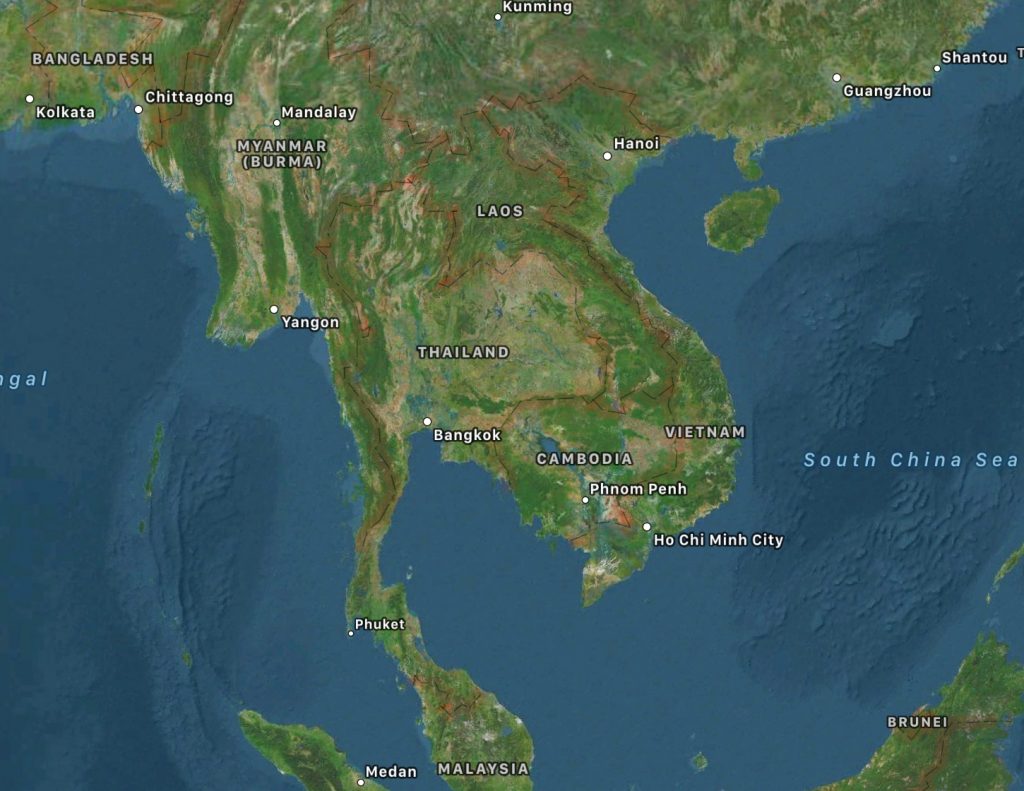
I began to study Chen Tai Chi in Bangkok, and decided to come back this year for 6 weeks to learn more.

Chen Tai Chi from Mel Malinowski on Vimeo.
This is a short clip to give you an idea what Chen Tai Chi is like. It is purposefully very slow. Done well, it is graceful, good exercise, and a kind of meditation.
I study Chen Tai Chi with the Chen Tai Chi Club of Thailand in Bangkok.
http://www.chentaichithailand.com/#welcome
[vc_row][vc_column][vc_masonry_media_grid grid_id=”vc_gid:1485343692900-e4ca6dd3-649b-1″ include=”4621,4623,4622,4620,4619,4618,4617,4616″][/vc_column][/vc_row]
I began by flying from Hobart, Tasmania to Bangkok via Melbourne, about 5,000 miles. I hit a little travel snag in Melbourne. Prior to giving me my boarding pass to Bangkok, Jetstar had to verify that I had a valid permission to visit Thailand. I explained that US citizens did not need a visa to visit Thailand (what I thought–we had never needed one). Upon doing a little more research for them, we determined that in fact US citizens are allowed a 30 day maximum visit without getting a visa. As Judy and I had always gone for less than 30 days, we had never bumped into this rule.
Jetstar politely told me that unless I could provide proof that I was departing Thailand within 30 days, they could not fly me there or they would be fined. As my Jetstar flight to Hanoi was 43 days later, that did not qualify. As my flight to Bangkok was leaving in 2 hours, I needed a quick solution!
I asked Jetstar what was the cheapest flight they had out of Thailand in 28 days. It was to Singapore, for $49. So I bought a ticket on that flight, not intending to use it. This got me my boarding pass for Bangkok, and I figured I could sort it out there.
I rented a nice one bedroom apartment in Bangkok, two blocks from where Judy and I usually stayed. On the 16th floor of a new building, with an exercise facility, pool, steam room and sauna (hardly need a sauna in Bangkok!), it is roomy and comfortable. (the steam room turned out to be helpful later when I got a nasty sinus and chest cold)
Food in Bangkok is delicious and inexpensive. For example, for a late breakfast yesterday, I had stir-fried chicken with vegetables for $2.12 USD:
Yum! For lunch, I went to our all-time favorite restaurant, Kinnaree Gourmet Thai, an upscale place with a great selection of dishes. For $12.64 including service, I had this:
Spicy pomelo salad, stir fry chicken and pork dishes
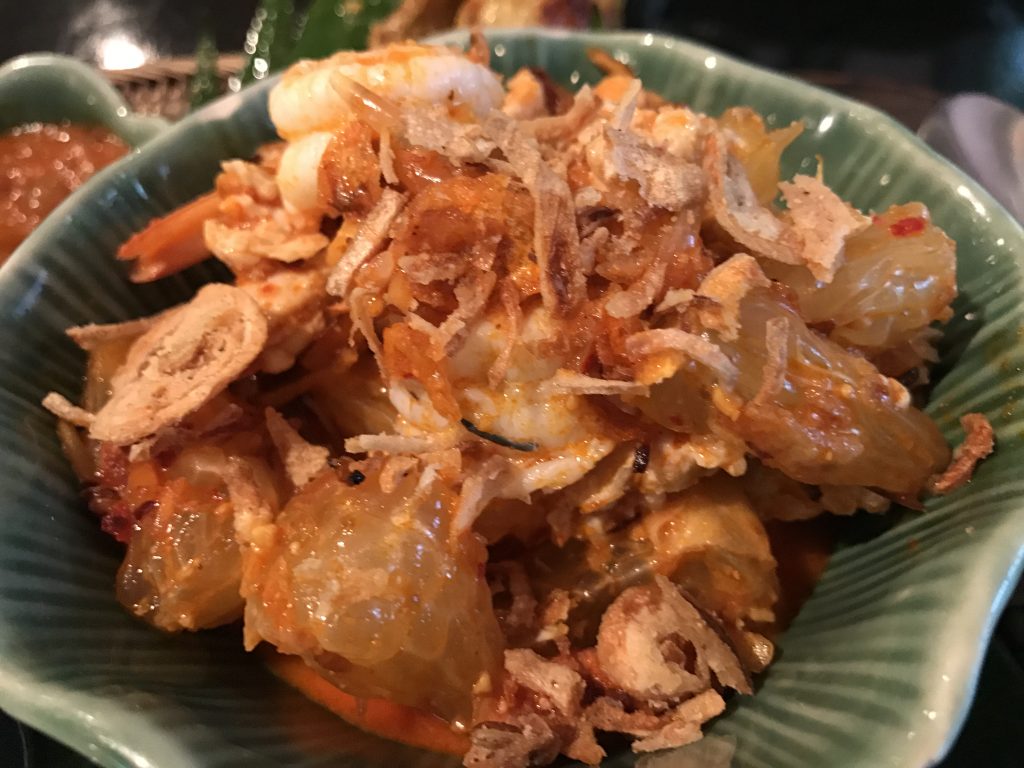
With fried banana and fresh coconut ice cream for dessert. I ate only half, brought the rest back for dinner. Pretty good deal! If I ate like this very often, I’d get too round to do Tai Chi, so I stick to simpler food most of the time. I mostly ate a mix of street vendor food and supermarket deli curries, supercharged at home with added spinach, broccoli, tofu and such.
After my first Tai Chi practice session in the park, I headed out to the Immigration Office by subway and taxi. After submitting several pages of forms, a picture, and paying about $54USD, I was granted permission to stay 60 days rather than just 30 days. So I don’t need to take that one day trip to Singapore. Had I gotten the visa in the US, it would have cost $40.
I think it is short-sighted of Thailand to make it difficult for visitors to stay more than 30 days, and to not allow applying for a visa more than 3 months ahead. As I am traveling all the time now, I never have time to be able to spare my passport and mail it in to get a visa. This may complicate some future travel to the extent that countries do not have electronic ways to get a visa (such as Russia and India!) The moral of this story is, however: always check on visa requirements ahead of time!
Making rice crepes in Bangkok from Mel Malinowski on Vimeo.
Kickball in Bangkok from Mel Malinowski on Vimeo.
Thailand has wonderful fruits. Whenever I am away from Thailand, I miss being able to get Thai pomelo. Pomelo is like a very large relative of grapefruit, perhaps 3x as big, and the Thai variety is not at all acidic like grapefruit. The result is a mild, refreshing fruit:
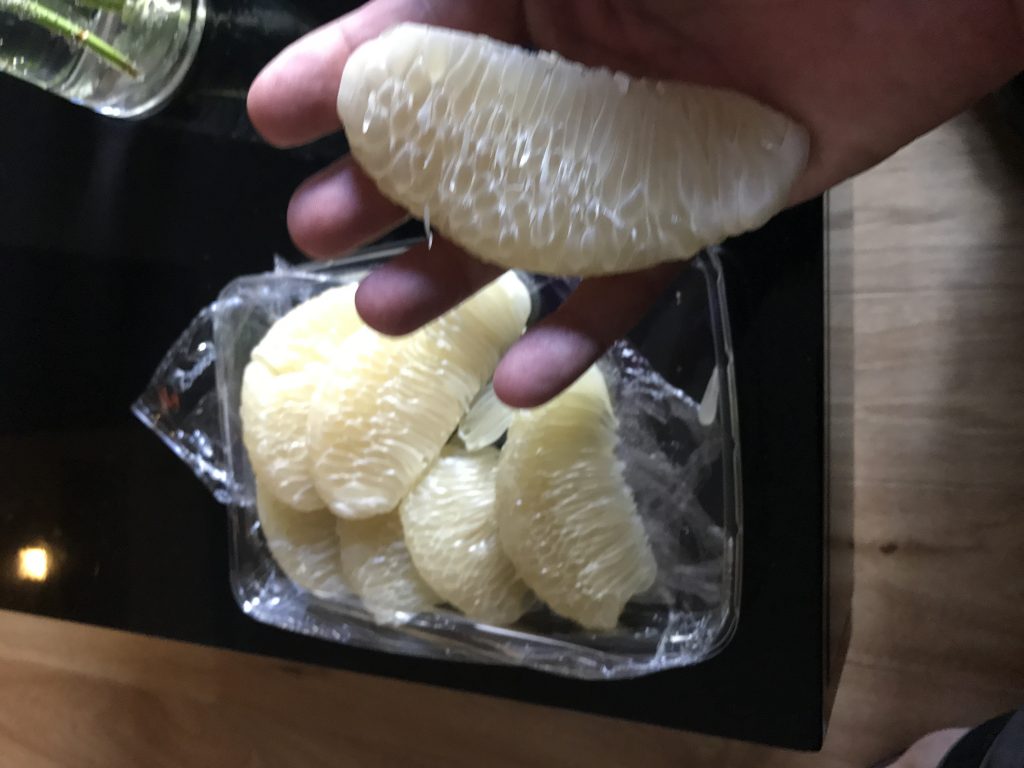
There are many street vendors in Bangkok making and selling quality food at lower prices than you pay in a restaurant. One of my favorite street vendors is usually selling on Soi 8, Sukhumvit, making Som Tum Thai among other things (green papaya salad with dried shrimp and peanuts). I have been eating her Som Tum for years, whenever we were staying here. It is my favorite lunch. At 40THB (about $1.12 USD) it is a bargain. It IS spicy.
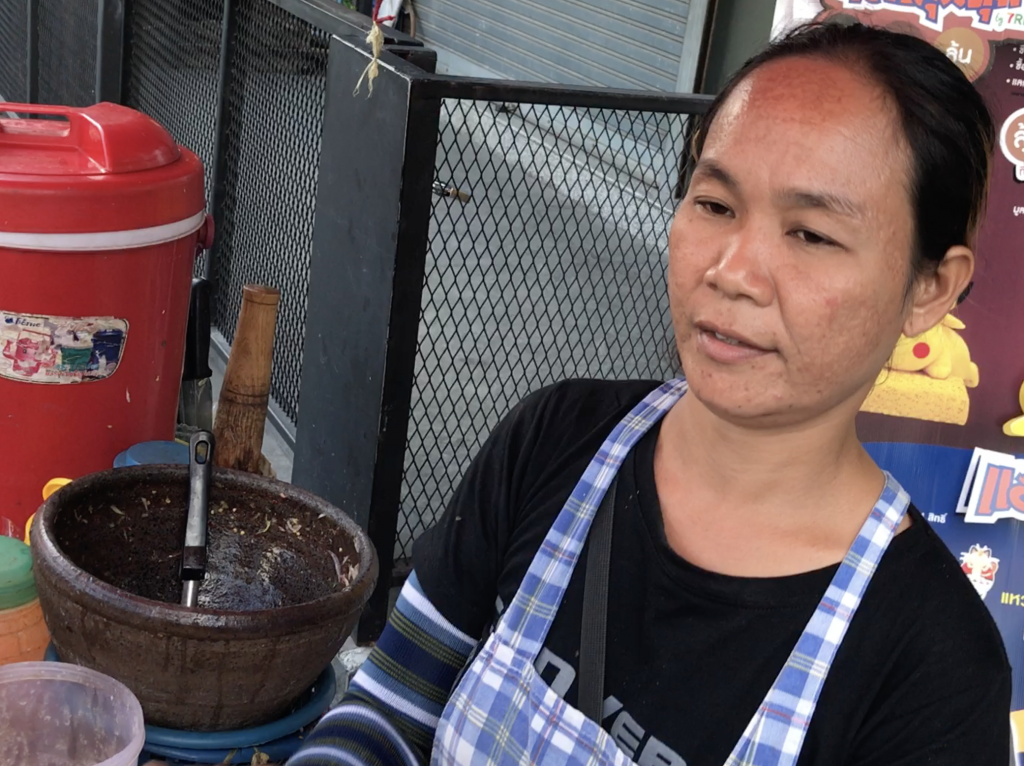
As you can see in the video below, making Som Tum Thai is complex and involves a lot of mixing and pounding. That this woman can stand here and do this for many hours amazes me. I doubt I would have the stamina to do so. Her food is very good, and she has a steady stream of customers. Alas, a week after I arrived she told me that she was going home to Issan (in northeastern Thailand) for 5 weeks. She will be missed.
Som Tum (Green Papaya salad) in Bangkok from Mel Malinowski on Vimeo.
This video shows her making Som Tum Lao, a variant with salted crab. I prefer Som Tum Thai. This video is about 2 minutes long. You can see her taste a piece of the salad. This is quality control: she always does this, and then will adjust the flavoring if needed. High standards are typical of Thai cooking.
Here are typical ingredients for Som Tum Thai:
2 cherry tomatoes
1 Thai chili pepper (2 if you like really hot)
1/2 tablespoon dried shrimp
3/4 tablespoon fish sauce
1/2 clove garlic
3 green beans, chopped
1 cup shredded green papaya
⅓ lime (squeeze in juice)
¾ tablespoon palm sugar
1 tablespoon toasted peanuts
[vc_row][vc_column][vc_masonry_media_grid grid_id=”vc_gid:1485748661281-747aeafedc69a3696f6e9e9ca6295f95-8″ include=”4628,4629,4630,4624,4631,4626,4627,4641,4644,4645,4643,4642″][/vc_column][/vc_row]
Thailand is a predominantly Buddhist culture, very old, and is a bit of a challenge to understand if you come from a European/American culture. I am far from qualified to explain it to you. There are many authors who try, with mixed success. I’ll just make a few observations from time to time here. Pay attention to Thai culture, and you can come to be as fond of it as we did.
I have rented a Jeep and driven in rural northern Thailand without problems. That said, I don’t recommend doing so in urban areas, as driving here is a big melodrama, and we don’t really know the informal rules. There is a lot of speed and bluffing involved, like a big road rally, and if you don’t know the game well, you could get hurt. It also can be no more expensive to hire a vehicle with driver than a rental car.
Being a pedestrian in Bangkok seems safer to me than in New York. This may be because of two Thai characteristics, the first being politeness. The second is a superior alertness to what is going on all around them. I think this is why the service in Thai restaurants is so excellent: if the water in your glass gets low, your Thai waiter will notice it before you do, and refill it.
Likewise, on the street, cars and motorcycles and tuk-tuks do their best to avoid the rudeness of hitting you (whereas in New York City, it seems there is a bounty on pedestrians–hitting them is always an option, but if not, blast them with your horn to get the h*ll out of your way). The Thai best may not be enough if you are totally oblivious and step out in front of a fast-moving vehicle, so try to cultivate Thai awareness and not do that. If you wish to keep your elbows intact. it is best to not flap them around obliviously like a chicken, lest a silent, speeding motorcycle inadvertently clip them. Learn self-awareness.
(note: my Tai Chi teacher says that, as anywhere, there are lesser skilled drivers that are a hazard, people have accidents, so things may not be as safe as I have so far experienced. Use care, and walk defensively)
I like flowers, as anyone following this blog knows by now. I went to a street vendor and got some cut flowers to dress up my apartment. Thailand is the favored home of many orchids.
Many things in Bangkok are inexpensive at current exchange rates. One of my favorites has become Thai oil massage. Tai Chi is strong exercise, and as the Tour de France riders know, good massage speeds your muscle recovery. In Hawai’i, spa massage costs $80-$200 an hour, and I have not seen it as the best way to spend our money. Here in Bangkok, however, a five star spa across the street from my apartment charges 500 Thai baht ($14.27 US dollars) for an hour of Thai oil massage. Every 11th massage is free, a 9% discount. A 50-100 baht tip is appropriate.

The massage begins with a wash and scrub of your feet (soothing and pleasant). Then you move to a stylish massage room, don disposable underwear for modesty, and lie down on a comfortable massage table. Then begins an hour of relaxing, flowing draped massage. I massaged Judy on a massage table every day while we were in Hawai’i, as it helped her relax, particularly as her health declined. I like oil massage because then the strokes can be long and smooth.
I have a favorite masseuse, whose name is Pin, and at my request, she does the massage Chen Tai Chi speed (very slowly) without poking too deeply. Ah…

Some of the artwork scattered around Silk Spa:
[vc_row][vc_column][vc_masonry_media_grid grid_id=”vc_gid:1486364837901-13aca59b-abc9-1″ include=”4658,4657,4659,4660″][/vc_column][/vc_row]

This week was a big motorcycle show here at the shopping mall called ‘Central World’. Motorcycles are considerably less expensive than cars, and can get through when the cars are at gridlock. Of course, everyone admires high performance motorcycles such as these racy Italian bikes made by Ducati. (Most you see on the streets are not this fancy, but one can dream).
One free attraction at the show was ‘The Wall of Death’. Inside a not so big round structure lined with boards angled at the bottom, then vertical along the sides, spectators got to stand around at the top while daredevil riders performed the stunt of riding parallel to the ground at high speed, held up only by centrifugal force. Anyone care to calculate how many Gs are pressing on the rider in order to keep the bike up there?

The first rider looked about 14 years old, but rode like a bat out of hell!
Wall of Death from Mel Malinowski on Vimeo.

Bangkok has many faces.
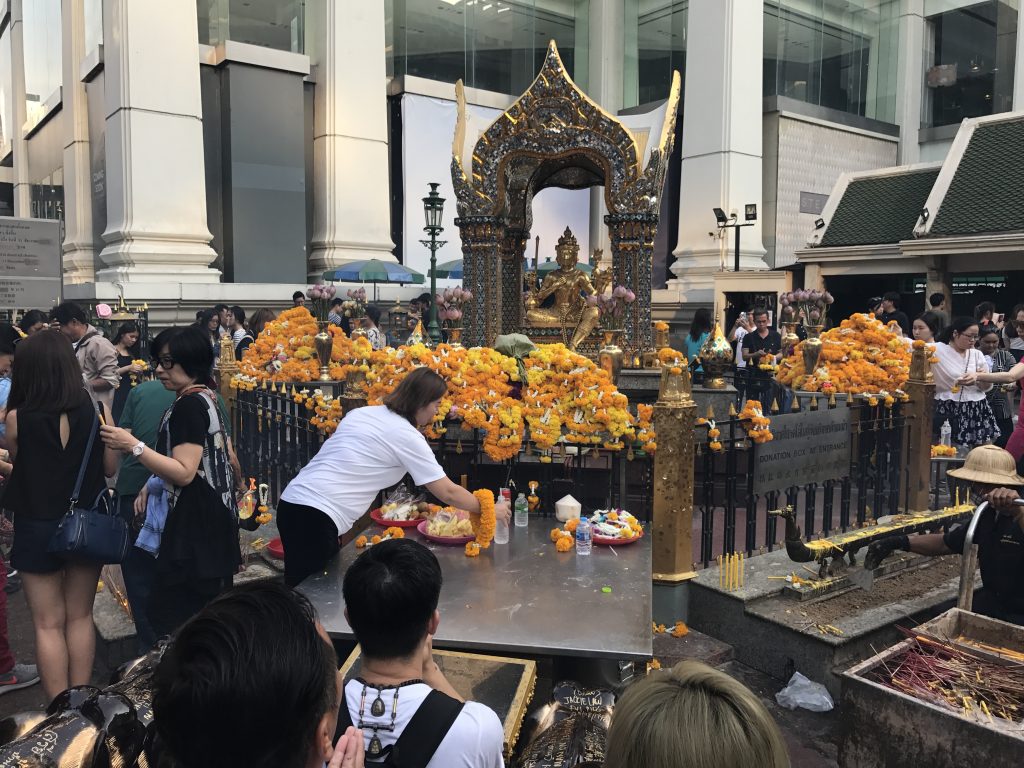
It is very much a Buddhist country.
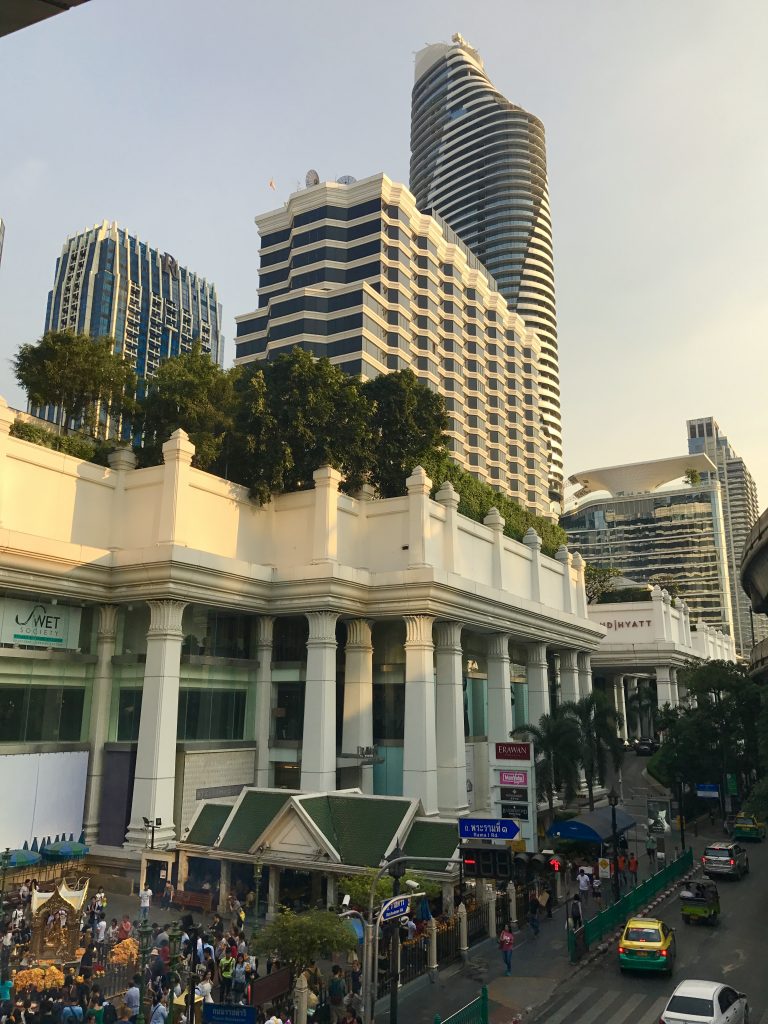
Yet look above and beyond that shrine to see the emerging modern Bangkok sprouting up from the very old traditional city.
In the time when I am not practicing Tai Chi, I have been getting back up to speed as an iOS programmer, learning Apple’s new language Swift. Apple is requiring all older apps to be recompiled and resubmitted for compatibility with the plethora of new devices. When I started iOS coding, there was just and iPhone, and then an iPad. Now, there are many sizes of both. I just completed a re-write of my simplest app, Travel Clock, aimed at frequent travelers and the visually impaired, and it now is in the App Store again, with added features. Next, I am working on making it available in Chinese, French, German, Spanish, Dutch and Thai, which is an interesting challenge. Good brain exercise.
![]()
My Tai Chi is progressing slowly. It is a challenge to explain it adequately, particularly as I am as yet a naive student with less than two months practice. But I will try.
Recently my instructor told us part of what he was trying to teach us was to learn ‘the edge of our balance’, for that was essential to exerting power if needed. Balance and weight distribution are important, and in the process, you certainly do improve your balance, awareness and strength. Tai Chi is excellent isometric exercise.
My teacher has warned me not to try to teach Tai Chi to others when I do not yet understand it myself. However, I will do my best to report on what it seems to be. You can skip this section if it does not interest you.
Tai Chi Chuan (太極拳) literally translates as “Ultimate Supreme Boxing”. The Chen family school is the oldest, and the parent source of all Tai Chi today. It is the one I have chosen to study.
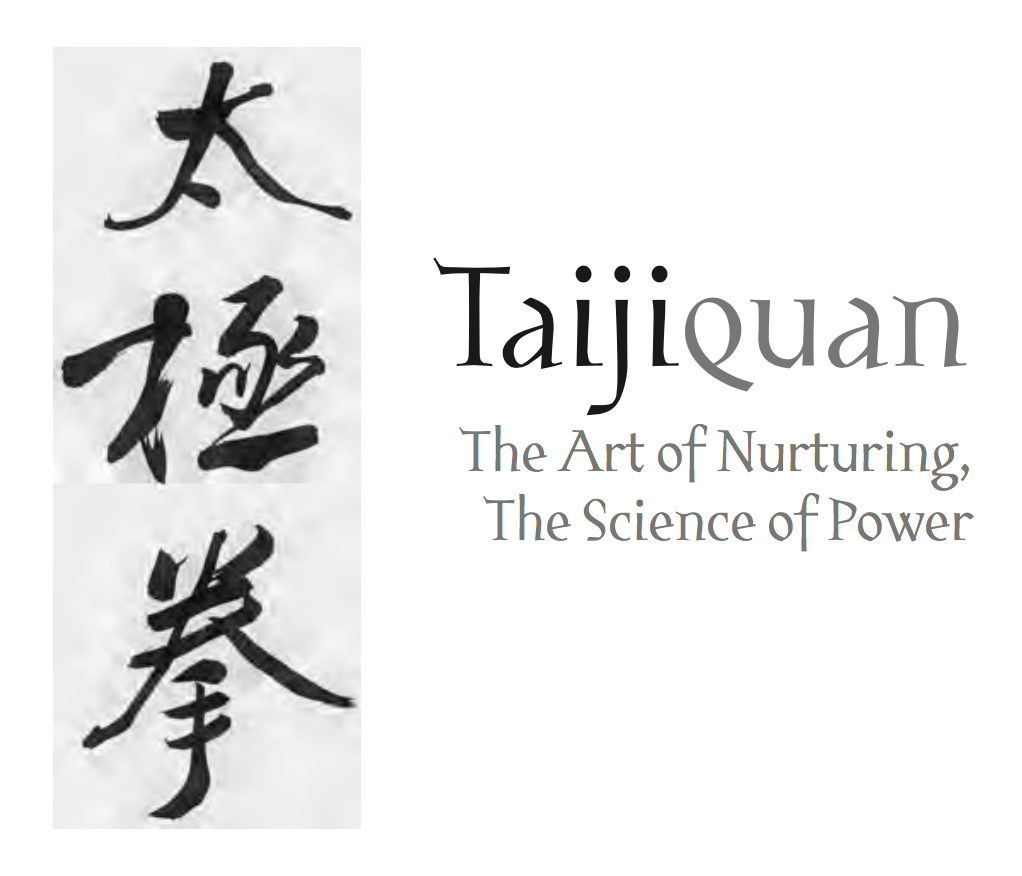
It has been described as an “internal martial art”, although to judge from the Tai Chi practiced by most adherents today, it looks more like a very slow, stylish dance/exercise. My teacher assures me that advanced students of it (in perhaps 20 years of work) have serious martial arts ability. He describes being out for a walk with his mum in the UK (he’s British) and being bothered by two large louts. With one fast, powerful move he knocked the first down to his surprise, and the second decided they should not bother him.
That is not my goal. I’m doing Tai Chi for the exercise and health benefits. Along the way, perhaps I may gain some of the spiritual benefits. We shall see.
(My Tai Chi teacher recommends avoided a fight whenever possible, using quick, strong force when absolutely necessary, and then breaking off as soon as possible. Think of this part of Tai Chi as self-defense)
There is an elevated train system that allows you to avoid the chronic Bangkok traffic jam (which is truly awful–once, after getting only ½ mile in half an hour, Judy and I just got out and walked!) The Skytrain seems expensive by Bangkok standards (rides from 15 to 50 Thai Baht (43 cents to $1.42 USD), as you can get a stir-fry chicken dish at Tops for 45 Baht. Yet the Skytrain is often packed. It is the fastest way to many destinations (assuming you are unwilling to risk the motorcycle alternative).

[vc_row][vc_column][vc_masonry_media_grid grid_id=”vc_gid:1488418921722-38559be8c4387adfc0689635c6b80df7-8″ include=”4693,4681,4697,4694,4696,4680,4705,4706,4707,4708,4709,4714,4711,4712,4713,4728,4727″][/vc_column][/vc_row]
More faces of Thailand
The word ‘taiji’ represents the interaction of yin and yang, which are complementary opposites. Taijiquan teaches that hardness comes from softness and quickness comes from slowness.
“The training exercises of Taiji…are designed to build gong. Physically, the accumulation of gong refers to constant improvements in balance, coordination, agility, sensitivity, and strength or power. Mentally and spiritually, the accumulation of gong refers to improved awareness and confidence, and constant advancements toward realizing tranquility of heart and mind.” –Taijiquan, the Art of Nurturing, the Science of Power, Yang Yang, Ph.D.
Now, I must practice, practice, practice, with the goal of moving the Tai Chi from external to internal. Perhaps you may see me among the millions of Chinese exercising and practicing many forms of martial arts in parks all over the world in the early mornings. I like that a lot better than exercising with machines in an air conditioned room.
Looking ahead…my time in Bangkok is drawing to a close. Next stop: Hanoi, Vietnam


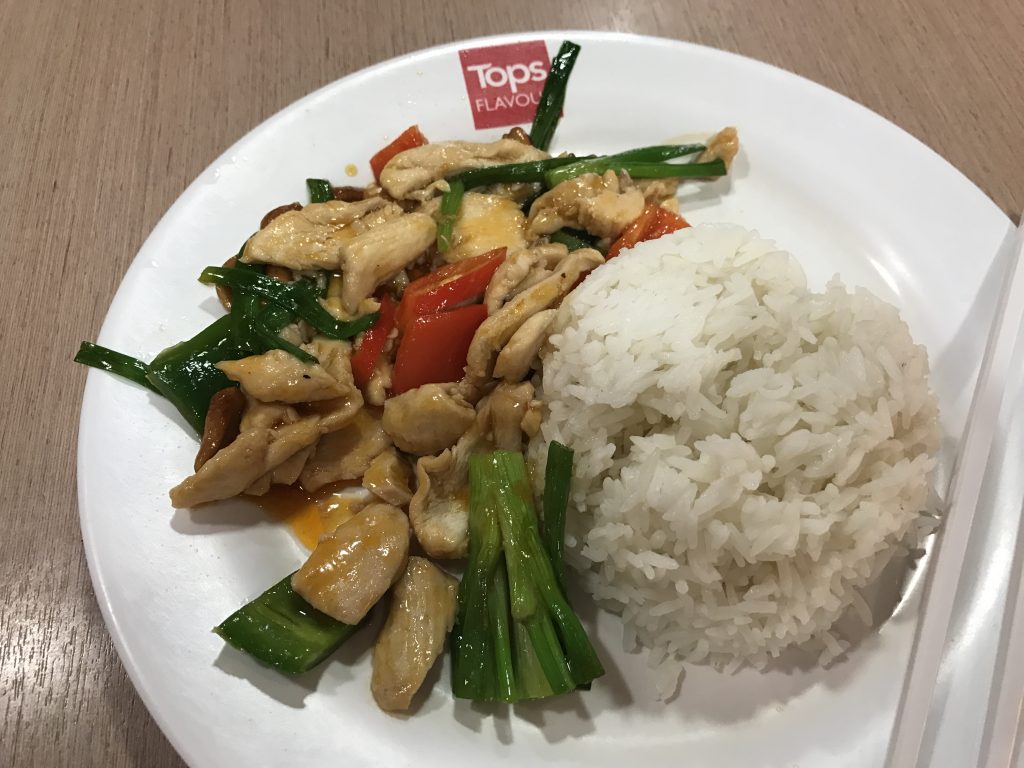
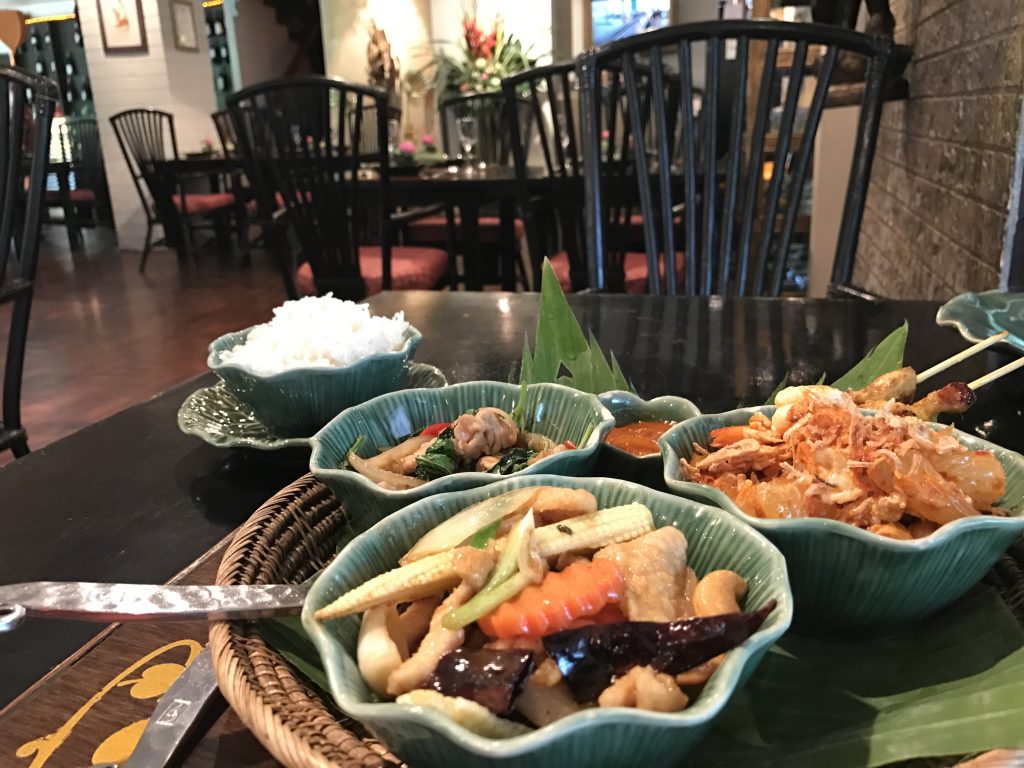

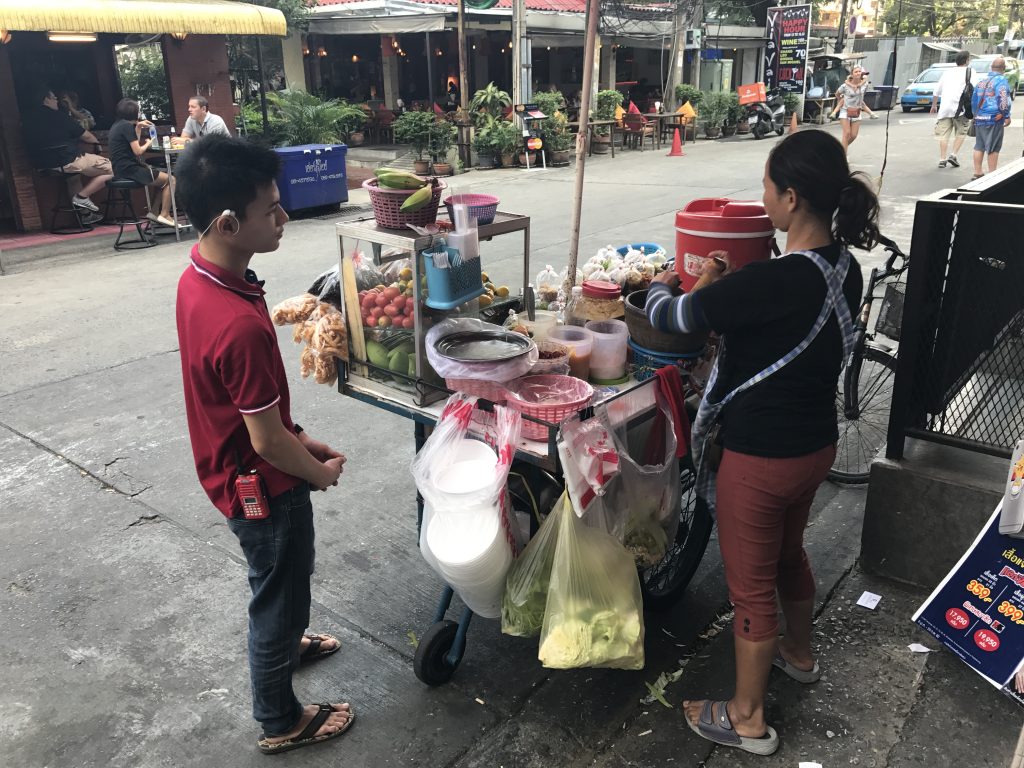
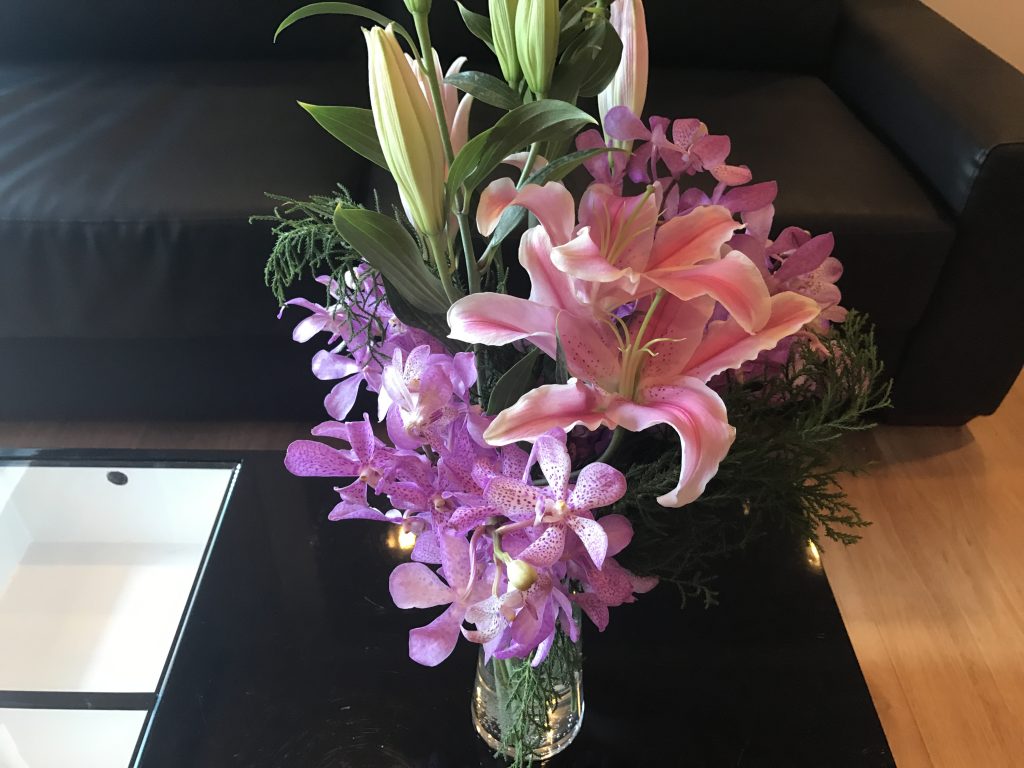

Leave a Reply
You must be logged in to post a comment.